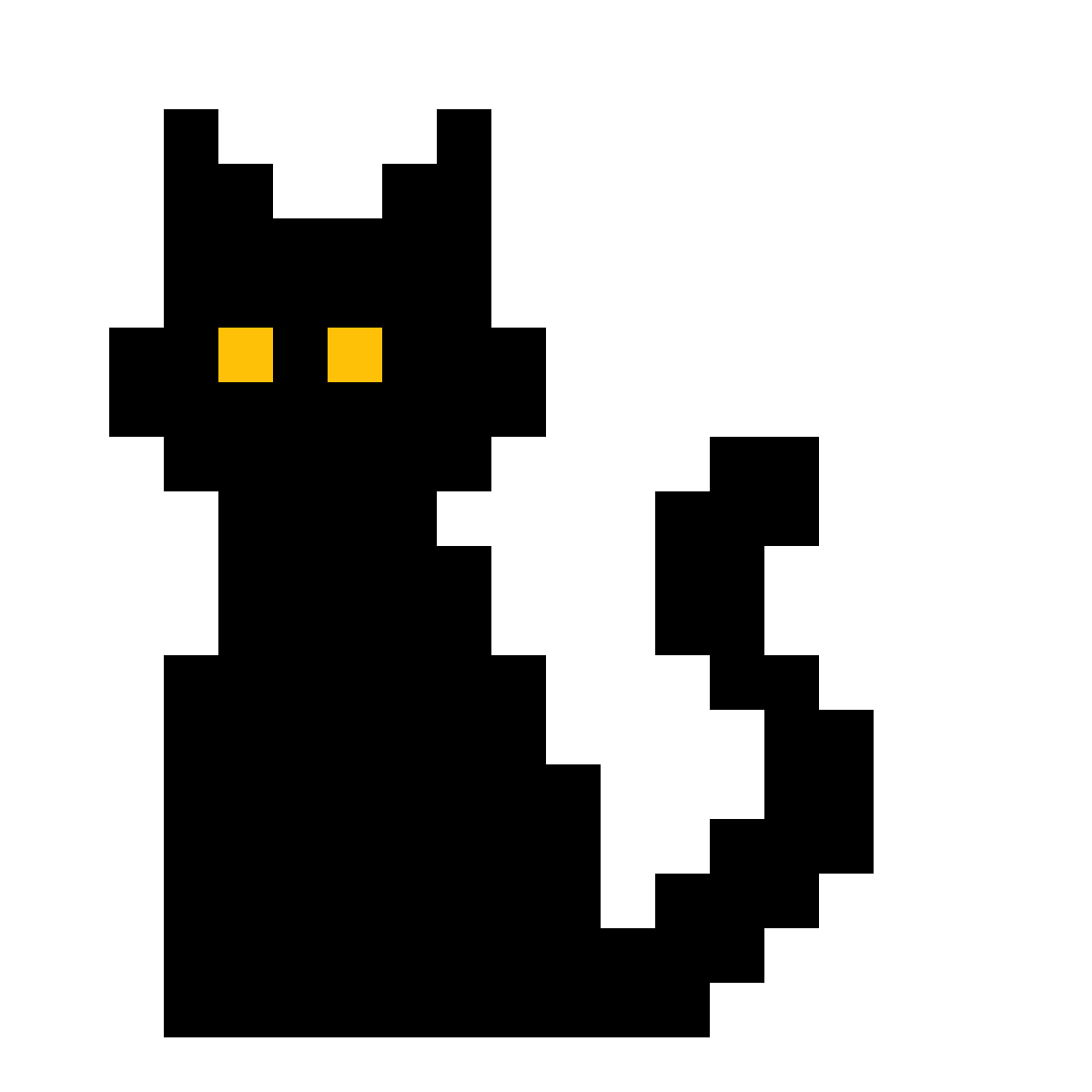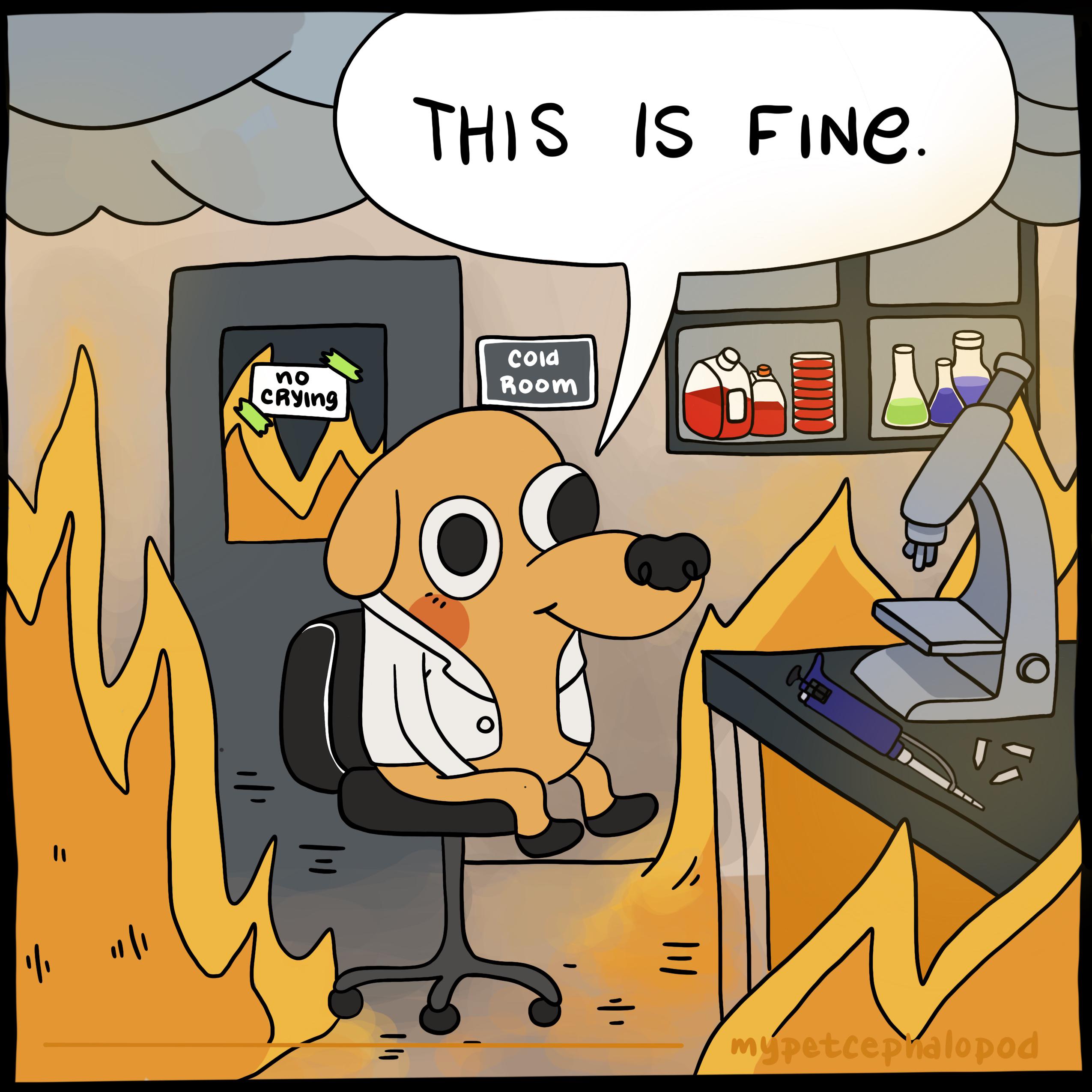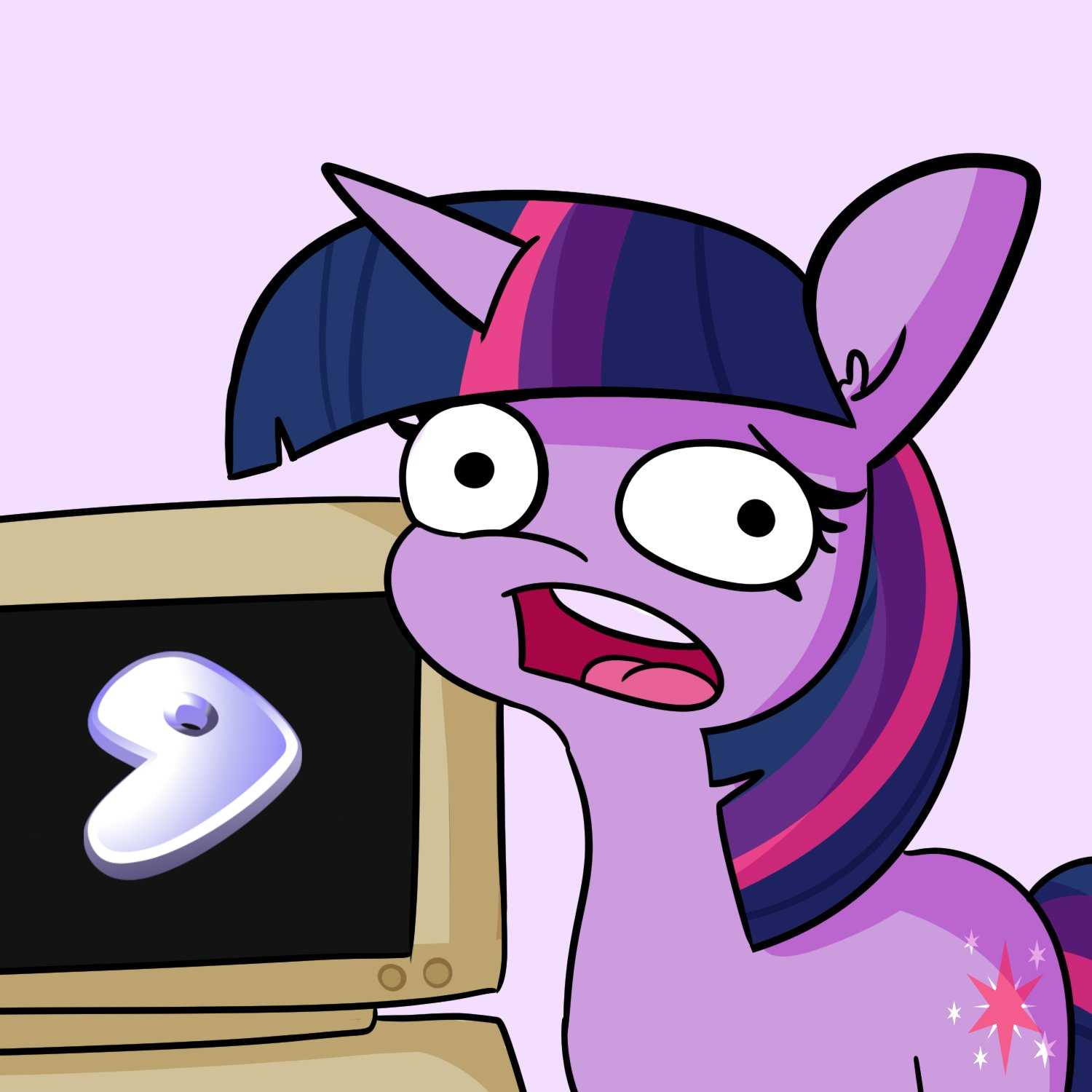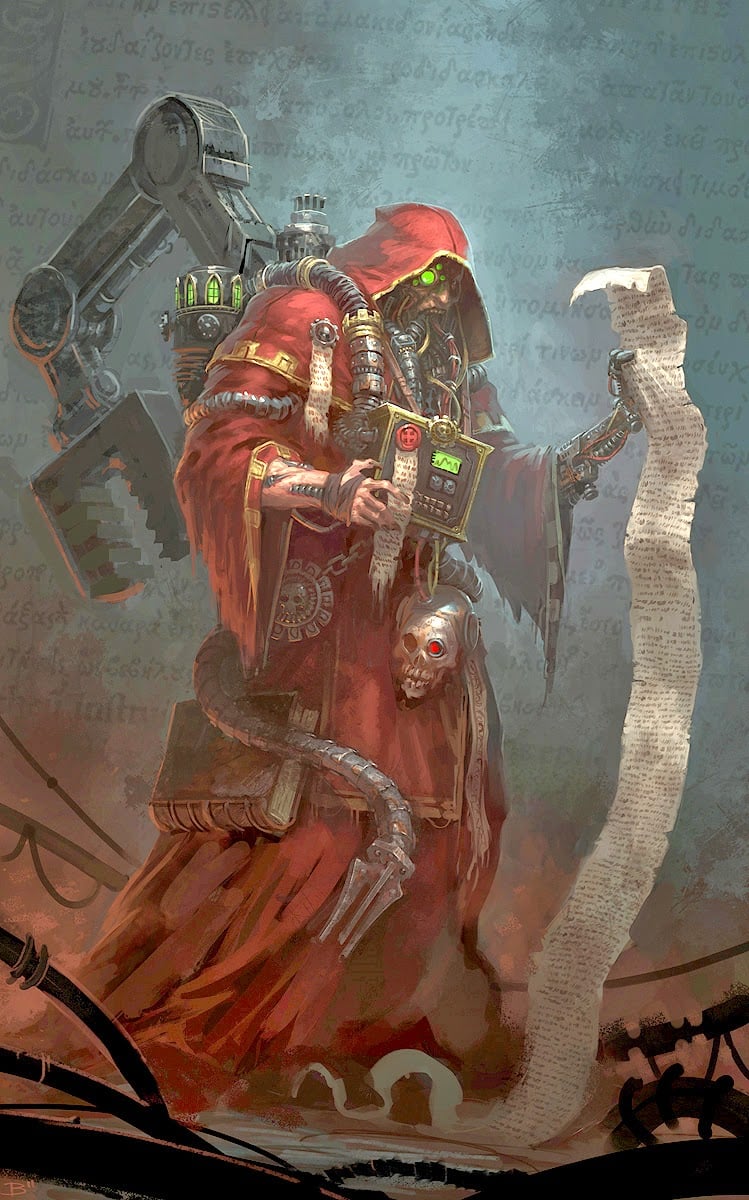x=.9999…
10x=9.9999…
Subtract x from both sides
9x=9
x=1
There it is, folks.
Somehow I have the feeling that this is not going to convince people who think that 0.9999… /= 1, but only make them madder.
Personally I like to point to the difference, or rather non-difference, between 0.333… and ⅓, then ask them what multiplying each by 3 is.
The thing is 0.333… And 1/3 represent the same thing. Base 10 struggles to represent the thirds in decimal form. You get other decimal issues like this in other base formats too
(I think, if I remember correctly. Lol)
I’d just say that not all fractions can be broken down into a proper decimal for a whole number, just like pie never actually ends. We just stop and say it’s close enough to not be important. Need to know about a circle on your whiteboard? 3.14 is accurate enough. Need the entire observable universe measured to within a single atoms worth of accuracy? It only takes 39 digits after the 3.
There are a lot of concepts in mathematics which do not have good real world analogues.
i, the _imaginary number_for figuring out roots, as one example.
I am fairly certain you cannot actually do the mathematics to predict or approximate the size of an atom or subatomic particle without using complex algebra involving i.
It’s been a while since I watched the entire series Leonard Susskind has up on youtube explaining the basics of the actual math for quantum mechanics, but yeah I am fairly sure it involves complex numbers.
i has nice real world analogues in the form of rotations by pi/2 about the origin (though this depends a little bit on what you mean by “real world analogue”).
Since i=exp(ipi/2), if you take any complex number z and write it in polar form z=rexp(it), then multiplication by i yields a rotation of z by pi/2 about the origin because zi=rexp(it)exp(ipi/2)=rexp(i(t+pi/2)) by using rules of exponents for complex numbers.
More generally since any pair of complex numbers z, w can be written in polar form z=rexp(it), w=uexp(iv) we have wz=(ru)exp(i(t+v)). This shows multiplication of a complex number z by any other complex number w can be thought of in terms of rotating z by the angle that w makes with the x axis (i.e. the angle v) and then scaling the resulting number by the magnitude of w (i.e. the number u)
Alternatively you can get similar conclusions by Demoivre’s theorem if you do not like complex exponentials.
Cut a banana into thirds and you lose material from cutting it hence .9999
That’s not how fractions and math work though.
I was taught that if 0.9999… didn’t equal 1 there would have to be a number that exists between the two. Since there isn’t, then 0.9999…=1
Unfortunately not an ideal proof.
It makes certain assumptions:
- That a number 0.999… exists and is well-defined
- That multiplication and subtraction for this number work as expected
Similarly, I could prove that the number which consists of infinite 9’s to the left of the decimal separator is equal to -1:
...999.0 = x ...990.0 = 10x Calculate x - 10x: x - 10x = ...999.0 - ...990.0 -9x = 9 x = -1And while this is true for 10-adic numbers, it is certainly not true for the real numbers.
X=.5555…
10x=5.5555…
Subtract x from both sides.
9x=5
X=1 .5555 must equal 1.
There it isn’t. Because that math is bullshit.
x = 5/9 is not 9/9. 5/9 = .55555…
You’re proving that 0.555… equals 5/9 (which it does), not that it equals 1 (which it doesn’t).
It’s absolutely not the same result as x = 0.999… as you claim.
0.9<overbar.> is literally equal to 1
There’s a Real Analysis proof for it and everything.
Basically boils down to
- If 0.(9) != 1 then there must be some value between 0.(9) and 1.
- We know such a number cannot exist, because for any given discrete value (say 0.999…9) there is a number (0.999…99) that is between that discrete value and 0.(9)
- Therefore, no value exists between 0.(9) and 1.
- So 0.(9) = 1
The decimals ‘0.999…’ and ‘1’ refer to the real numbers that are equivalence classes of Cauchy sequences of rational numbers (0.9, 0.99, 0.999,…) and (1, 1, 1,…) with respect to the relation R: (aRb) <=> (lim(a_n-b_n) as n->inf, where a_n and b_n are the nth elements of sequences a and b, respectively).
For a = (1, 1, 1,…) and b = (0.9, 0.99, 0.999,…) we have lim(a_n-b_n) as n->inf = lim(1-sum(9/10^k) for k from 1 to n) as n->inf = lim(1/10^n) as n->inf = 0. That means that (1, 1, 1,…)R(0.9, 0.99, 0.999,…), i.e. that these sequences belong to the same equivalence class of Cauchy sequences of rational numbers with respect to R. In other words, the decimals ‘0.999…’ and ‘1’ refer to the same real number. QED.
0.(9)=0.(3)*3=1/3*3=1
The way I see it is the difference between equal numbers is zero.
The difference between 0.999… and 1 is 0.000…, and since the nines don’t end, the zeros don’t end, so the difference is just zero.
Meaning 0.999… = 1
This is why we can’t have nice things like dependable protection from fall damage while riding a boat in Minecraft.
Remember when US politicians argued about declaring Pi to 3?
Would have been funny seeing the world go boink in about a week.
Some software can be pretty resilient. I ended up watching this video here recently about running doom using different values for the constant pi that was pretty nifty.
To everyone who might not have heard about that before: It was an attempt to introduce it as a bill in Indiana:
https://en.m.wikipedia.org/w/index.php?title=Indiana_pi_bill
the bill’s language and topic caused confusion; a member proposed that it be referred to the Finance Committee, but the Speaker accepted another member’s recommendation to refer the bill to the Committee on Swamplands, where the bill could “find a deserved grave”.
An assemblyman handed him the bill, offering to introduce him to the genius who wrote it. He declined, saying that he already met as many crazy people as he cared to.
I hope medicine in 1897 was up to the treatment of these burns.
Are we still doing this 0.999… thing? Why, is it that attractive?
The rules of decimal notation don’t sipport infinite decimals properly. In order for a 9 to roll over into a 10, the next smallest decimal needs to roll over first, therefore an infinite string of anything will never resolve the needed discrete increment.
Thus, all arguments that 0.999… = 1 must use algebra, limits, or some other logic beyond decimal notation. I consider this a bug with decimals, and 0.999… = 1 to be a workaround.
i don’t think any number system can be safe from infinite digits. there’s bound to be some number for each one that has to be represented with them. it’s not intuitive, but that’s because infinity isn’t intuitive. that doesn’t mean there’s a problem there though. also the arguments are so simple i don’t understand why anyone would insist that there has to be a difference.
for me the simplest is:
1/3 = 0.333…
so
3×0.333… = 3×1/3
0.999… = 3/3
Any my argument is that 3 ≠ 0.333…
EDIT: 1/3 ≠ 0.333…
We’re taught about the decimal system by manipulating whole number representations of fractions, but when that method fails, we get told that we are wrong.
In chemistry, we’re taught about atoms by manipulating little rings of electrons, and when that system fails to explain bond angles and excitation, we’re told the model is wrong, but still useful.
This is my issue with the debate. Someone uses decimals as they were taught and everyone piles on saying they’re wrong instead of explaining the limitations of systems and why we still use them.
For the record, my favorite demonstration is useing different bases.
In base 10: 1/3 ≈ 0.333… 0.333… × 3 = 0.999…
In base 12: 1/3 = 0.4 0.4 × 3 = 1
The issue only appears if you resort to infinite decimals. If you instead change your base, everything works fine. Of course the only base where every whole fraction fits nicely is unary, and there’s some very good reasons we don’t use tally marks much anymore, and it has nothing to do with math.
Any my argument is that 3 ≠ 0.333…
After reading this, I have decided that I am no longer going to provide a formal proof for my other point, because odds are that you wouldn’t understand it and I’m now reasonably confident that anyone who would already understands the fact the proof would’ve supported.
Ah, typo. 1/3 ≠ 0.333…
It is my opinion that repeating decimals cannot properly represent the values we use them for, and I would rather avoid them entirely (kinda like the meme).
Besides, I have never disagreed with the math, just that we go about correcting people poorly. I have used some basic mathematical arguments to try and intimate how basic arithmetic is a limited system, but this has always been about solving the systemic problem of people getting caught by 0.999… = 1. Math proofs won’t add to this conversation, and I think are part of the issue.
Is it possible to have a coversation about math without either fully agreeing or calling the other stupid? Must every argument about even the topic be backed up with proof (a sociological one in this case)? Or did you just want to feel superior?
It is my opinion that repeating decimals cannot
Your opinion is incorrect as a question of definition.
I have never disagreed with the math
You had in the previous paragraph.
Is it possible to have a coversation about math without either fully agreeing or calling the other stupid?
Yes, however the problem is that you are speaking on matters that you are clearly ignorant. This isn’t a question of different axioms where we can show clearly how two models are incompatible but resolve that both are correct in their own contexts; this is a case where you are entirely, irredeemably wrong, and are simply refusing to correct yourself. I am an algebraist understanding how two systems differ and compare is my specialty. We know that infinite decimals are capable of representing real numbers because we do so all the time. There. You’re wrong and I’ve shown it via proof by demonstration. QED.
They are just symbols we use to represent abstract concepts; the same way I can inscribe a “1” to represent 3-2={ {} } I can inscribe “.9~” to do the same. The fact that our convention is occasionally confusing is irrelevant to the question; we could have a system whereby each number gets its own unique glyph when it’s used and it’d still be a valid way to communicate the ideas. The level of weirdness you can do and still have a valid notational convention goes so far beyond the meager oddities you’ve been hung up on here. Don’t believe me? Look up lambda calculus.
don’t sipport infinite decimals properly
Please explain this in a way that makes sense to me (I’m an algebraist). I don’t know what it would mean for infinite decimals to be supported “properly” or “improperly”. Furthermore, I’m not aware of any arguments worth taking seriously that don’t use logic, so I’m wondering why that’s a criticism of the notation.
Decimal notation is a number system where fractions are accomodated with more numbers represeting smaller more precise parts. It is an extension of the place value system where very large tallies can be expressed in a much simpler form.
One of the core rules of this system is how to handle values larger than the highest digit, and lower than the smallest. If any place goes above 9, set that place to 0 and increment the next place by 1. If any places goes below 0, increment the place by (10) and decrement the next place by one (this operation uses a non-existent digit, which is also a common sticking point).
This is the decimal system as it is taught originally. One of the consequences of it’s rules is that each digit-wise operation must be performed in order, with a beginning and an end. Thus even getting a repeating decimal is going beyond the system. This is usually taught as special handling, and sometimes as baby’s first limit (each step down results in the same digit, thus it’s that digit all the way down).
The issue happens when digit-wise calculation is applied to infinite decimals. For most operations, it’s fine, but incrementing up can only begin if a digit goes beyong 9, which never happens in the case of 0.999… . Understanding how to resolve this requires ditching the digit-wise method and relearing decimals and a series of terms, and then learning about infinite series. It’s a much more robust and applicable method, but a very different method to what decimals are taught as.
Thus I say that the original bitwise method of decimals has a bug in the case of incrementing infinite sequences. There’s really only one number where this is an issue, but telling people they’re wrong for using the tools as they’ve been taught isn’t helpful. Much better to say that the tool they’re using is limited in this way, then showing the more advanced method.
That’s how we teach Newtonian Gravity and then expand to Relativity. You aren’t wrong for applying newtonian gravity to mercury, but the tool you’re using is limited. All models are wrong, but some are useful.
I can’t help but notice you didn’t answer the question.
each digit-wise operation must be performed in order
I’m sure I don’t know what you mean by digit-wise operation, because my conceptuazation of it renders this statement obviously false. For example, we could apply digit-wise modular addition base 10 to any pair of real numbers and the order we choose to perform this operation in won’t matter. I’m pretty sure you’re also not including standard multiplication and addition in your definition of “digit-wise” because we can construct algorithms that address many different orders of digits, meaning this statement would also then be false. In fact, as I lay here having just woken up, I’m having a difficult time figuring out an operation where the order that you address the digits in actually matters.
Later, you bring up “incrementing” which has no natural definition in a densely populated set. It seems to me that you came up with a function that relies on the notation we’re using (the decimal-increment function, let’s call it) rather than the emergent properties of the objects we’re working with, noticed that the function doesn’t cover the desired domain, and have decided that means the notation is somehow improper. Or maybe you’re saying that the reason it’s improper is because the advanced techniques for interacting with the system are dissimilar from the understanding imparted by the simple techniques.
In base 10, if we add 1 and 1, we get the next digit, 2.
In base 2, if we add 1 and 1 there is no 2, thus we increment the next place by 1 getting 10.
We can expand this to numbers with more digits: 111(7) + 1 = 112 = 120 = 200 = 1000
In base 10, with A representing 10 in a single digit: 199 + 1 = 19A = 1A0 = 200
We could do this with larger carryover too: 999 + 111 = AAA = AB0 = B10 = 1110 Different orders are possible here: AAA = 10AA = 10B0 = 1110
The “carry the 1” process only starts when a digit exceeds the existing digits. Thus 192 is not 2Z2, nor is 100 = A0. The whole point of carryover is to keep each digit within the 0-9 range. Furthermore, by only processing individual digits, we can’t start carryover in the middle of a chain. 999 doesn’t carry over to 100-1, and while 0.999 does equal 1 - 0.001, (1-0.001) isn’t a decimal digit. Thus we can’t know if any string of 9s will carry over until we find a digit that is already trying to be greater than 9.
This logic is how basic binary adders work, and some variation of this bitwise logic runs in evey mechanical computer ever made. It works great with integers. It’s when we try to have infinite digits that this method falls apart, and then only in the case of infinite 9s. This is because a carry must start at the smallest digit, and a number with infinite decimals has no smallest digit.
Without changing this logic radically, you can’t fix this flaw. Computers use workarounds to speed up arithmetic functions, like carry-lookahead and carry-save, but they still require the smallest digit to be computed before the result of the operation can be known.
If I remember, I’ll give a formal proof when I have time so long as no one else has done so before me. Simply put, we’re not dealing with floats and there’s algorithms to add infinite decimals together from the ones place down using back-propagation. Disproving my statement is as simple as providing a pair of real numbers where doing this is impossible.
Are those algorithms taught to people in school?
Once again, I have no issue with the math. I just think the commonly taught system of decimal arithmetic is flawed at representing that math. This flaw is why people get hung up on 0.999… = 1.
People generally find it odd and unintuitive that it’s possible to use decimal notation to represent 1 as .9~ and so this particular thing will never go away. When I was in HS I wowed some of my teachers by doing proofs on the subject, and every so often I see it online. This will continue to be an interesting fact for as long as decimal is used as a canonical notation.
Okay, but it equals one.
No, it equals 0.999…
2/9 = 0.222… 7/9 = 0.777…
0.222… + 0.777… = 0.999… 2/9 + 7/9 = 1
0.999… = 1
No, it equals 1.
That’s the best explanation of this I’ve ever seen, thank you!
That’s more convoluted than the 1/3, 2/3, 3/3 thing.
3/3 = 0.99999…
3/3 = 1
If somebody still wants to argue after that, don’t bother.
Nah that explanation is basically using an assumption to prove itself. You need to first prove that 1/3 does in fact equal .3333… which can be done using the ‘convoluted’ but not so convoluted proof
Sure, when you start decoupling the numbers from their actual values. The only thing this proves is that the fraction-to-decimal conversion is inaccurate. Your floating points (and for that matter, our mathematical model) don’t have enough precision to appropriately model what the value of 7/9 actually is. The variation is negligible though, and that’s the core of this, is the variation off what it actually is is so small as to be insignificant and, really undefinable to us - but that doesn’t actually matter in practice, so we just ignore it or convert it. But at the end of the day 0.999… does not equal 1. A number which is not 1 is not equal to 1. That would be absurd. We’re just bad at converting fractions in our current mathematical understanding.
Edit: wow, this has proven HIGHLY unpopular, probably because it’s apparently incorrect. See below for about a dozen people educating me on math I’ve never heard of. The “intuitive” explanation on the Wikipedia page for this makes zero sense to me largely because I don’t understand how and why a repeating decimal can be considered a real number. But I’ll leave that to the math nerds and shut my mouth on the subject.
If they aren’t equal, there should be a number in between that separates them. Between 0.1 and 0.2 i can come up with 0.15. Between 0.1 and 0.15 is 0.125. You can keep going, but if the numbers are equal, there is nothing in between. There’s no gap between 0.1 and 0.1, so they are equal.
What number comes between 0.999… and 1?
(I used to think it was imprecise representations too, but this is how it made sense to me :)
It’s a correct proof.
One way to think about this is that we represent numbers in different ways. For example, 1 can be 1.0, or a single hash mark, or a dot, or 1/1, or 10/10. All of them point to some platonic ideal world version of the concept of the number 1.
What we have here is two different representations of the same number that are in a similar representation. 1 and 0.999… both point to the same concept.
My brother. You are scared of infinities. Look up the infinite hotel problem. I will lay it out for you if you are interested.
Image you are incharge of a hotel and it has infinite rooms. Currently your hotel is at full capacity… Meaning all rooms are occupied. A new guest arrives. What do you do? Surely your hotel is full and you can’t take him in… Right? WRONG!!! You tell the resident of room 1 to move to room 2, you tell the resident of room 2 to move to room 3 and so on… You tell the resident of room n to move to room n+1. Now you have room 1 empty
But sir… How did I create an extra room? You didn’t. The question is the same as asking yourself that is there a number for which n+1 doesn’t exist. The answer is no… I can always add 1.
Infinity doesn’t behave like other numbers since it isn’t technically a number.
So when you write 0.99999… You are playing with things that aren’t normal. Maths has come with fuckall ways to deal with stuff like this.
Well you may say, this is absurd… There is nothing in reality that behaves this way. Well yes and no. You know how the building blocks of our universe obey quantum mechanics? The equations contain lots of infinities but only at intermediate steps. You have to “renormalise” them to make them go away. Nature apparently has infinities but likes to hide the from us.
The infinity problem is so fucked up. You know the reason physics people are unable to quantize gravity? Surely they can do the same thing to gravity as they did to say electromagnetic force? NOPE. Gravitation doesn’t normalise. You get left with infinities in your final answer.
Anyways. Keep on learning, the world has a lot of information and it’s amazing. And the only thing that makes us human is the ability to learn and grow from it. I wish you all the very best.
But sir… How did I create an extra room? You didn’t.
When Hilbert runs the hotel, sure, ok. Once he sells the whole thing to an ultrafinitist however you suddenly notice that there’s a factory there and all the rooms are on rails and infinity means “we have a method to construct arbitrarily more rooms”, but they don’t exist before a guest arrives to occupy them.
It still equals 1, you can prove it without using fractions:
x = 0.999…
10x = 9.999…
10x = 9 + 0.999…
10x = 9 + x
9x = 9
x = 1
There’s even a Wikipedia page on the subject
I hate this because you have to subtract .99999… from 10. Which is just the same as saying 10 - .99999… = 9
Which is the whole controversy but you made it complicated.
It would be better just to have them do the long subtraction
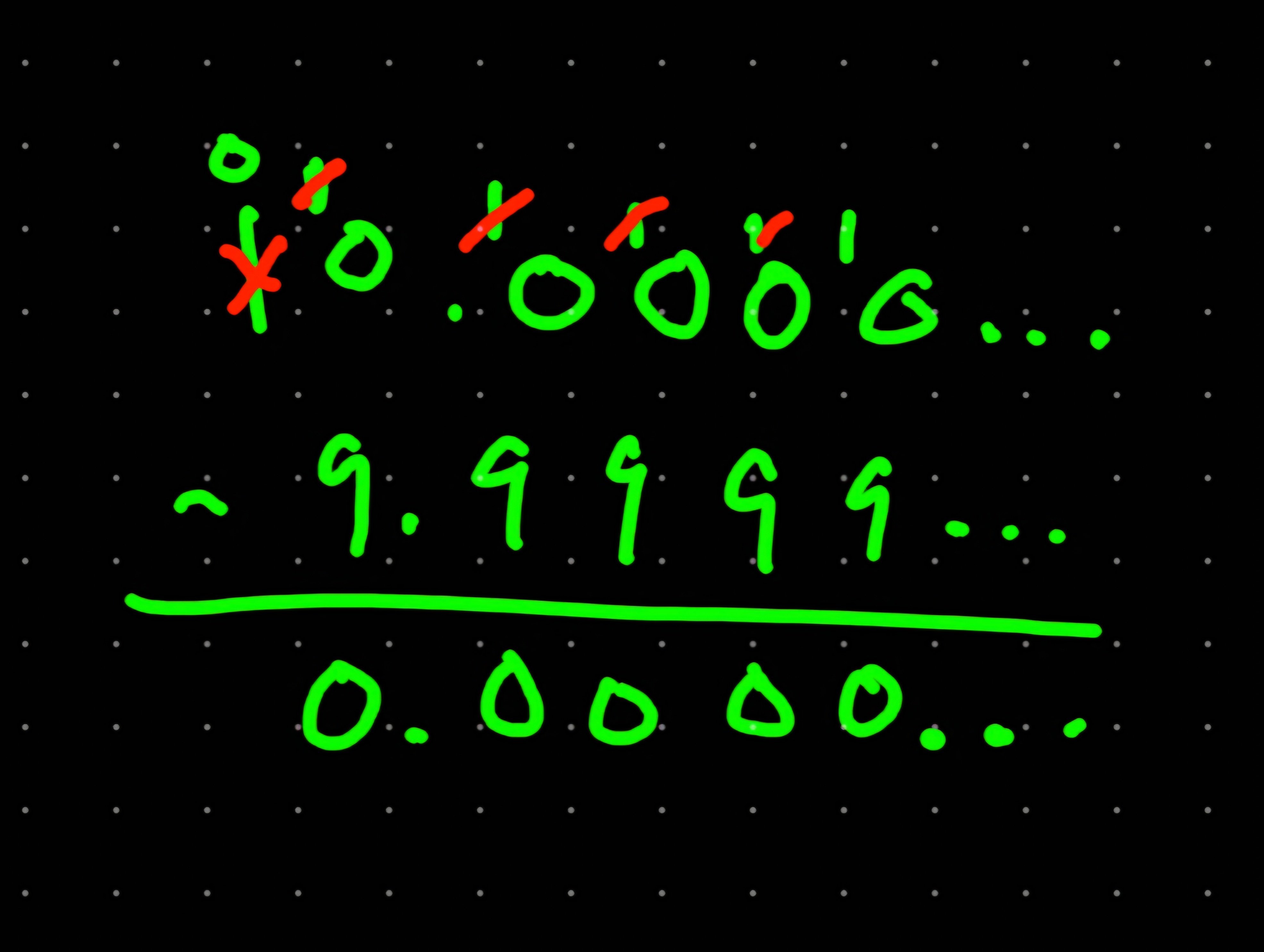
If they don’t get it and keep trying to show you how you are wrong they will at least be out of your hair until forever.
You don’t subtract from 10, but from 10x0.999… I mean your statement is also true but it just proves the point further.
No, you do subtract from 9.999999…
I strongly agree with you, and while the people replying aren’t wrong, they’re arguing for something that I don’t think you said.
1/3 ≈ 0.333… in the same way that approximating a circle with polygons of increasing side number has a limit of a circle, but will never yeild a circle with just geometry.
0.999… ≈ 1 in the same way that shuffling infinite people around an infinite hotel leaves infinite free rooms, but if you try to do the paperwork, no one will ever get anywhere.
Decimals require you to check the end of the number to see if you can round up, but there never will be an end. Thus we need higher mathematics to avoid the halting problem. People get taught how decimals work, find this bug, and then instead of being told how decimals are broken, get told how they’re wrong for using the tools they’ve been taught.
If we just accept that decimals fail with infinite steps, the transition to new tools would be so much easier, and reflect the same transition into new tools in other sciences. Like Bohr’s Atom, Newton’s Gravity, Linnaean Taxonomy, or Comte’s Positivism.
Decimals require you to check the end of the number to see if you can round up, but there never will be an end.
The character sequence “0.999…” is finite and you know you can round up because you’ve got those three dots at the end. I agree that decimals are a shit representation to formalise rational numbers in but it’s not like using them causes infinite loops. Unless you insist on writing them, that is. You can compute with infinities just fine as long as you keep them symbolic.
That only breaks down with the reals where equality is fundamentally incomputable. Equality of the rationals and approximate equality of reals is perfectly computable though, the latter meaning that you can get equality to arbitrary, but not actually infinite, precision. You can specify a number of digits you want, you can say “don’t take longer than ten seconds to compute”, any kind of bound. Once the precision goes down to plank lengths I think any reasonable engineer would build a bridge with it.
…sometimes I do think that all those formalists with all those fancy rules about fancy limits are actually way more confused about infinity than freshman CS students.
Eh, if you need special rules for 0.999… because the special rules for all other repeating decimals failed, I think we should just accept that the system doesn’t work here. We can keep using the workaround, but stop telling people they’re wrong for using the system correctly.
The deeper understanding of numbers where 0.999… = 1 is obvious needs a foundation of much more advanced math than just decimals, at which point decimals stop being a system and are just a quirky representation.
Saying decimals are a perfect system is the issue I have here, and I don’t think this will go away any time soon. Mathematicians like to speak in absolutely terms where everything is either perfect or discarded, yet decimals seem to be too simple and basal to get that treatment. No one seems to be willing to admit the limitations of the system.
Noone in the right state of mind uses decimals as a formalisation of numbers, or as a representation when doing arithmetic.
But the way I learned decimal division and multiplication in primary school actually supported periods. Spotting whether the thing will repeat forever can be done in finite time. Constant time, actually.
The deeper understanding of numbers where 0.999… = 1 is obvious needs a foundation of much more advanced math than just decimals
No. If you can accept that 1/3 is 0.333… then you can multiply both sides by three and accept that 1 is 0.99999… Primary school kids understand that. It’s a bit odd but a necessary consequence if you restrict your notation from supporting an arbitrary division to only divisions by ten. And that doesn’t make decimal notation worse than rational notation, or better, it makes it different, rational notation has its own issues like also not having unique forms (2/6 = 1/3) and comparisons (larger/smaller) not being obvious. Various arithmetic on them is also more complicated.
The real take-away is that depending on what you do, one is more convenient than the other. And that’s literally all that notation is judged by in maths: Is it convenient, or not.
The system works perfectly, it just looks wonky in base 10. In base 3 0.333… looks like 0.1, exactly 0.1
If you can’t do it without fractions or a … then it can’t be done.
1/3=0.333…
2/3=0.666…
3/3=0.999…=1
Fractions and base 10 are two different systems. You’re only approximating what 1/3 is when you write out 0.3333…
The … is because you can’t actually make it correct in base 10.
What exactly do you think notations like 0.999… and 0.333… mean?
That it repeats forever, to no end. Because it can never actually be correct, just that the difference becomes insignificant.
Sure, let’s do it in base 3. 3 in base 3 is 10, and 3^(-1) is 10^(-1), so:
1/3 in base 10 = 1/10 in base 3
0.3… in base 10 = 0.1 in base 3Multiply by 3 on both sides:
3 × 0.3… in base 10 = 10 × 0.1 in base 3
0.9… in base 10 = 1 in base 3.But 1 in base 3 is also 1 in base 10, so:
0.9… in base 10 = 1 in base 10
You’re having to use … to make your conversion again. If you need to to an irrational number to make your equation correct, it isn’t really correct.
The fractions are still in base 10 lmfao literally what the fuck are you talking about and where are getting this from?
You keep getting basic shit wrong, and it makes you look dumb. Stop talking and go read a wiki.
We’ve found a time traveller from ancient Greece…
Edit: sorry. I mean we’ve found a time traveller from ancient Mesopotamia.
I wish computers could calculate infinity
Computers can calculate infinite series as well as anyone else
